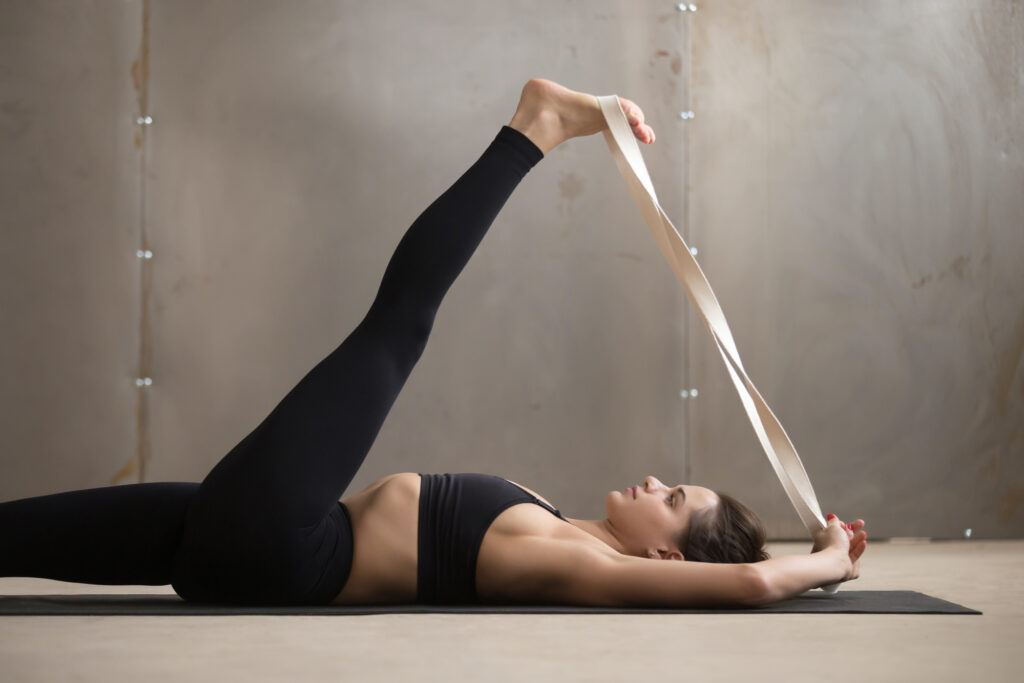Learn Supta Padangusthasana and keep your hamstrings stretched

Supta Padangusthasana is the quintessential asana to stretch hamstrings, calves and the glutes. It can be considered a challenging asana, and for that, there are multiple variations of this pose. These adjustments also allow focussing on different muscles and actions, therefore, all of them are not only amazing but important to learn.
Here we’ll focus on Supta Padangusthasana A. It’s important to learn all the essentials of the basic asana, to move on to other variations. Keep reading and find out more!
Receive all our tips by email!
Love Astrology? Subscribe Now and Receive Exclusive Content!
Building Supta Padangusthasana
Supta Padangusthasana guarantees the stretching hamstrings, calves and glutes muscles without compromising the lower back. Therefore, it is the safest choice if you need to stretch any of these muscles and your lower back is showing some problems. Besides that, it allows to stretch the pelvic flexor muscles of the extended leg.
Learn how to do Supta Padangusthasana A, step-by-step:
- Lay down on the floor and extend your legs with toes pointing the sky;
- Exhale while you bend the left knee and holding with your hands into your torso;
- Loop a strap on the left foot around the arch. Hold the strap with both hands;
- Exhale and straighten the left leg. Try to keep the toes in the direction of your head;
- You can either keep the back on the floor if the focus is to stretch; or exhale and take your torso on the direction of your leg if the goal is to build strength.
- Hold the position for 8 breaths;
- Exhale and release;
- Repeat to the other side.

Get into the details
- Contract the abdomen (as if you were going to bring it in the leg’s direction) and the quadriceps to extend that same leg, allows a deeper relaxation in the stretch;
- To avoid the flexion of the extended leg on the floor, contract the glutes and quadriceps, creating pressure with the heels against the floor and the intention of dragging the foot to the outside;
- Keep the shoulder blades pressing slightly into the floor while widening the collarbones away from the sternum;
- If you are starting the yoga practice and you don’t have much flexibility, adapt the Supta Padangusthasana by keeping the leg on the floor bent. Once you feel you have conquered the stability in this pose, start experimenting stretching it on the floor with the previous details considered.
Variations of Supta Padangusthasana
We are going to mention two variations of Supta Padangusthasana, considering there are many other possibilities. It’s possible to make a sequence using the three poses mentioned in this article.
1. From Supta Padangusthasana A, exhale and slowly lower your leg to the side (if the left leg is raised, lower it to the left side), entering in Supta Padangusthasana B. Hold your leg a few centimeters away from the floor, while you keep pulling your foot in your direction. Inhale and slowly raise the leg again.
- Keep the opposite hip pressing on the direction of the floor, otherwise, the effect of this asana with being neutralized.
2. From Supta Padangusthasana A, exhale and take the leg to its opposite direction (if it’s the left leg, in the right direction). Hold it for a few breaths and as you inhale bring the leg back to the original position.
- Keep the hip from the straight leg, pressing against the floor in order to take full advantage of the asana.
Supta Padangusthasana is also a great pose to stabilize the back after back bending asanas, like Ustrasana, so it’s usually present closer to the end of the sequences. Test it for your own and feel all the benefits coming from it.
You may also like:
- The ultimate guide for yoga types and benefits
- Yoga injuries: tips to avoid them
- Yoga and strength: 5 asanas for strong arms

